
each year, the governor of Virginia announces November is Virginia Indian Heritage Month
Source: Commonwealth of Virginia, Governor McDonnell Signs Proclamation Designating November as Virginia Indian Heritage Month (November 8, 2013)

each year, the governor of Virginia announces November is Virginia Indian Heritage Month
Source: Commonwealth of Virginia, Governor McDonnell Signs Proclamation Designating November as Virginia Indian Heritage Month (November 8, 2013)
The first human residents of Virginia left virtually no written materials about their culture. We don't have the diaries, reports, or other records of a "literate" society as source material for understanding a different culture, in a different time. We have to evaluate other evidence to determine - or guess - at their religious beliefs, political boundaries, population levels, family life, and other social patterns. The physical evidence still available for study - shards of pottery, animal bones, postholes of houses, etc.- are subject to interpretation.
English listeners recorded the words spoken by Powhatan. (He was also called Wahunsenacawh or Wahunsunacock, as recorded by the English immigrants in the early 1600's - spelling of the original Virginia names by the English is not 100% consistent.) His words are not first-hand records; they were not written directly by Powhatan himself. In addition to the inevitable errors in translation, the written records of the Europeans must be viewed in the context of the 1500's and 1600's rather than the first decade of the 21st Century. The early English were not necessarily "New Age, sensitive kinds of guys" who made anthropologically-neutral observations. The first Europeans to explore Virginia filtered what they saw through their world view.
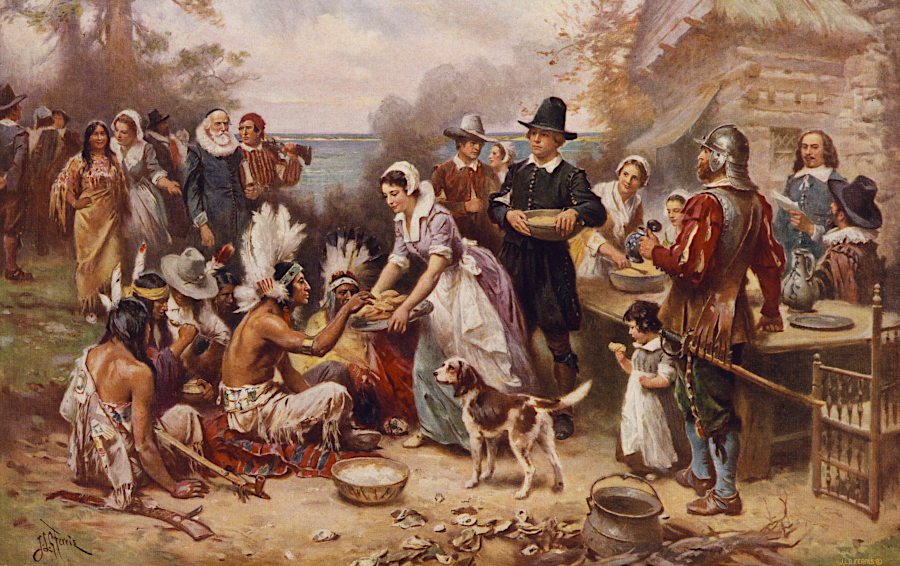
myths and cultural biases shape how many people imagine the colonists and Native Americans first interacted with each other
Source: Library of Congress, The first Thanksgiving 1621 (J.L.G. Ferris, c.1932)
The vast majority of English explorers/colonists who came to Virginia were Protestants and nationalists. The idea that there should be a separation between church and state, that government should be secular and individuals left free to choose their own personal faith, was far in the future. The Europeans who arrived in Virginia considered it a natural way of life that the English would displace the Native Americans, as well as prevent settlement in Virginia by French and Spanish Catholics.
The "pagan" culture of the Natives was described by those educated enough to read and write in the early 1600's. Those recorders were not 100% neutral; they had been thoroughly exposed to the religious and political bias of their time. The descriptions of the early explorers include overt and hidden value judgments that shade our current understanding of the lifestyles of the First Virginians. When you read the original documents, try to anticipate the source material that was omitted as well as the way the recorded material was morphed by the biases of the colonial times.
Modern historians, scientists, and students are affected by cultural biases as well. For example, do you assume the ability to read and write (literacy) is fundamental to intelligence? Do you notice spelling errors in documents, and discount the quality of the thinking because the writing was flawed? If so, then you may be consciously or unconsciously assuming that the Native Americans were not intelligent. If so, be consistent and assume Shakespeare was not intelligent - because his spelling was inconsistent.
If you visit one of the colonial Virginia mansions, tour guides will talk about the Carter, Lee, Randolph, Bolling, and occasionally even the Grymes family as "First Families of Virginia" (FFV's) The FFV's were the gentry - the white, Anglo-Saxon, Protestant gentry - who governed the economic, social, and political life of colonial Virginia between 1607-1776. "Colonial" is the time between when Jamestown was settled in 1607 and 1776, when a special convention of colonial leaders declared Virginia to be an independent state.
In the 1600's and 1700's, members of the gentry families established plantations, purchased slaves, grew tobacco, and built brick mansions such as Gunston Hall, Stratford Hall and Berkeley Plantation. There was even a "Grymesby on the Piankatank" - what a mixture of Native and English names...
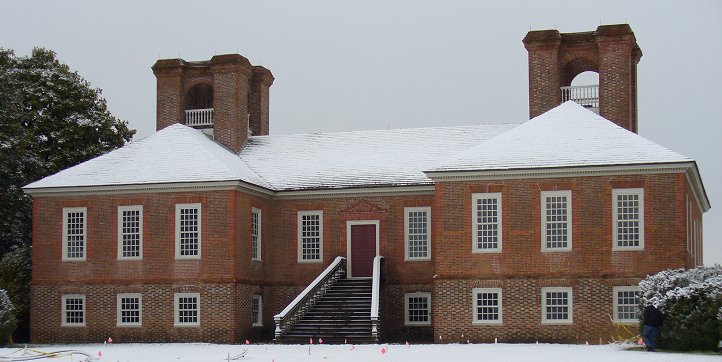
Stratford Hall, ancestral home of the Lee family
Men controlled the Virginia General Assembly and local county courts in colonial times. No women and no slaves (male or female) could vote. Political and economic power was not shared or spread around any more than necessary.
The sons and daughters of FFV families married sons and daughters of other FFV's, and inherited wealth - primarily land and slaves, both considered necessary property for growing tobacco that was shipped to Europe - stayed in the family. The oldest male son inherited the majority of the family wealth, a pattern known as primogeniture. Inherited land was kept within family control for generations, entailed by the wills of long-dead ancestors.
In modern Virginia, especially in rural areas of Tidewater and Southside and in the West End suburbs of Richmond, being related to one of the early colonial families is a badge of honor. These FFV's think "To be a Virginian either by Birth, Marriage, Adoption, or even on one's Mother's side is an Introduction to any State in the Union, a Passport to any Foreign Country, and a Benediction from Above."
Despite such traditional Virginia gentry myths, the very first FFV's did not speak with a British accent. The earliest human residents in Virginia probably walked here from Asia through Alaska, after crossing a land bridge hundreds of miles wide known as Beringea.
Those immigrants may have come directly from Siberia, following the game through fields and marshes exposed as the sea level dropped. The early arrivals may have been trapped on the edge of Siberia/Alaska for thousands of years, isolated from others and interbreeding until the genetic diversity was limited. There is even a chance that the first Virginians paddled here from Europe about 15,000 years ago, bringing stone manufacturing traditions from the Burgundy region of France near the rock of Solutre.1
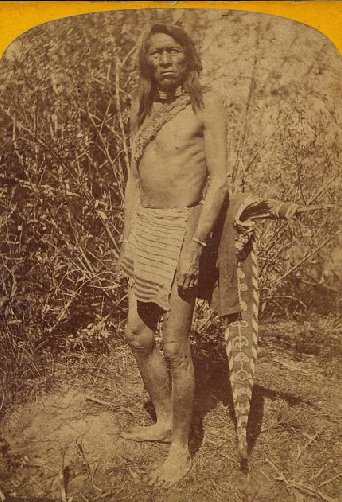
the first Virginian would not have resembled this individual, because the climate 15,000 years ago was colder.
Source: Library of Congress
When the English immigrants got to Virginia, they were greeted by the real "first" Virginians. The next time someone argues about the discovery of America by the Vikings from Scandinavia, or suggests the English had a legitimate claim on the area by Right of Discovery because it was unoccupied by any Christian prince, or challenges the presence of immigrants from foreign nations - remember that Virginia was discovered and occupied first by people who did not speak English.
Our knowledge about the earliest Virginians is unclear. The traveling band whose descendants ultimately occupied North and South America may have been just 70 people. It is possible that just one single family group may have been the source for all the Indians who were "discovered" by the Europeans.2
More likely, multiple hunting/gathering bands brought genetic diversity to the Western Hemisphere, and the different groups arrived at different times before the end of the last Ice Age. Some may have arrived as much as 20,000 years ago. There were at least three waves of immigration from Asia, with the Inuit arriving last about 4,000 years ago.3
We do not have enough evidence to prove beyond a reasonable doubt when humans first came to Virginia, or how they got here. The traditional view, that Asians walked across the Bering Land Bridge, may be expanded to include arrivals from other directions. We can be positive about one thing, however: the first Virginians did not arrive in the Susan Constant, Godspeed, and Discovery in 1607.
About 25,000 years ago, so much water was captured in the ice blanketing the continents that sea level was as much as 400' lower. Lower sea levels exposed the land now under the Bering Sea. Until 14,000 years ago, there was still wet-but-walkable ground that connected modern-day Alaska with modern-day Russia.
Asians who crossed the Bering Land Bridge walked east and south, following new territory for hunting game. The hunting and gathering efforts may have led bands to move 10 miles in a day as they explored the virgin lands. At night, they may have told tall tales to each other and occasionally to other bands of hunters, anticipating what food, forests, rivers, and ice barriers would be found over the next ridge. They could have followed the "kelp highway," walking on rocky coastlines where food was available from both sea and land.4
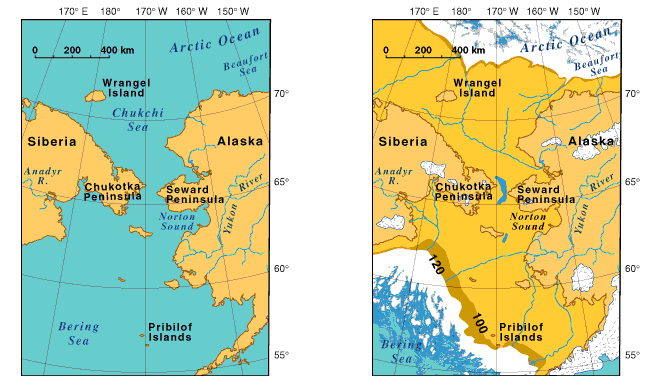
Bering Straight, now and then
Source: USGS Ecosystem and Climate History of Alaska
For over 50 years, scholars thought the first artifacts documenting human settlement in North America were stone tools crafted in the style of the Clovis culture. The tools were first discovered in the 1930's near Clovis, New Mexico and dated to be about 13,000 years old. Recent studies in the last 30 years show clear evidence that there was a pre-Clovis culture, one that arrived in North America as early as 15,000-20,000 or so years ago.
At Cactus Hill (site 44SX202) and Blueberry Hill in Sussex County (site 44SX327), stone artifacts have been excavated carefully a few inches below Clovis-style artifacts. Older materials are buried below younger materials, so the discovery of artifacts beneath Clovis artifacts suggests that the first Virginians were here:5
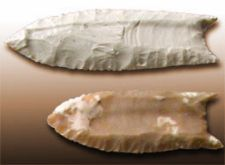
Clovis point and (below) a later Folsom point, showing distinctive notches from the base up through center of point
Source: Bureau of Land Management, Wilson Butte Cave
Some archaeologists still question if Virginia was occupied by humans before the development of the distinctive stone tools of the Clovis culture. Critical thinking skills are required when someone states anything related to Virginia before 1600 as "true." What we know today may not be what we believe tomorrow, as new evidence surfaces and new interpretations are based on new evidence.
In 1996, a skeleton was discovered on the Columbia River in the Pacific Northwest. "Kennewick Man" was radiocarbon dated at roughly 9,000 years old. The Federal government planned to turn over the bones to a local Native American tribe for burial, following the 1990 Native American Graves Protection and Repatriation Act. That law mandates that ancient human bones must be turned over to the most closely-allied tribe for reburial.
However, anthropologists sought access to the bones for scientific research and sued to block the reburial. The scientists challenged the assumption that all bones older than 1492 (when Columbus "sailed the ocean blue") must be connected with a modern Native American tribe.6
One speculation was that the bones indicated Polynesian or even European immigrants may have reached North America nearly 10,000 years ago, separately from those hunting bands that crossed the Bering land bridge. The lawsuit generated extensive discussion on the definition of race and who were the earliest settlers in North America, thousands of years before Columbus. The courts ultimately ruled that the bones are not associated closely enough with any current tribe to require repatriation to a modern tribe under the provisions of the Native American Graves Protection and Repatriation Act, and scientists got 16 days to examine the remains.7
That study led scientists to conclude that Kennewick Man was a traveler from Alaska, someone who drank water from glaciers and ate marine animals such as seals, sea lions and fish. Though the bones were found inland from the Pacific Ocean shoreline, he was a maritime hunter-gatherer who originated with the same group of people that later populated Polynesian islands and Japan. Members of that group may have paddled along the shoreline of Beringea 9,000 years ago to reach different hunting grounds on the coastline of North America, and some may have gone inland for brief visits to trade for different types of stone tools and food.
The unusual physical characteristics of the skeleton may demonstrate just the naturally wide range of skull sizes and shapes within the Native American population living in the Pacific Northwest 9,000 years ago. On the other hand, it may indicate the Ainu people of Japan or Polynesians managed to migrate to North America in a fourth wave of immigration across the Bering land bridge before rising sea levels drowned that path.8
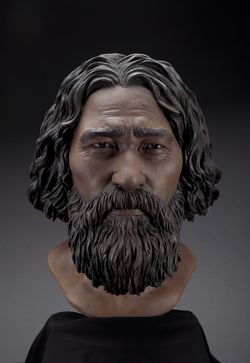
Kennewick Man may have looked like this
Source: Smithsonian Institution, The 9,000 year-old Kennewick Man
Our perspectives on the past are changing fast. For example, the old assumption that corn imported from Mexico was key to the development of agriculture in Virginia is now outdated. Native Americans in the Mississippi River Valley domesticated different plant species long before tobacco and corn were imported from the south. The Native Americans in Virginian added corn as a major food source plant only around 1,000 years ago:9
Even assumptions about Native American origins for Virginia place names are changing. Maybe Shenandoah really does mean Daughter of the Stars, but evidence for that claim is thin. Layers and layers of Virginia tradition may be repeated often by tourism officials, but still lack primary sources.
Chesapeake, name of the largest bay in Virginia, is of Native American origin. Roanoke, Meherrin, and Nottoway are Native American names for Virginia rivers, but they were not the original names used by the first Virginians. Place names used by Native Americans in the early 1600's (before the Europeans arrived) had little or no relationship to the first names assigned to those places by the first settlers who arrived as much as 15,000 years earlier. Paleo-Indians did not speak Iroquoian, Siouan, or Algonquian languages.
The English changed the name of Powhatan's River to James River to honor a ruler in London, but a name change for that natural feature was not new. The Native Americans under Powhatan's control would have used the name Powhatan's River for just the last 30 or so years. Perhaps the name of the previous paramount chief who ruled prior to Powhatan had been assigned to that river, or perhaps it had been called something as mundane as "Big River."
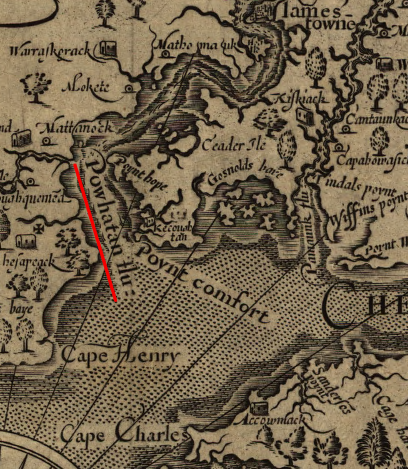
on John Smith's map, the James River was labeledPowhatan's flu (flu=river)
Source: Library of Congress, Virginia / discovered and discribed by Captayn John Smith, 1606
The English referred to Virginia rather than Tsenacomoco, the term used by Powhatan's Algonquians to describe the region where they lived. What was the first name for the place we now call Virginia? No one knows; the Paleoindians left no records providing any clues to their languages.
What we do know is that the first Virginians, maybe 15,000 years ago, did not speak the Algonquian language or have a chief called Powhatan. The original names of the Virginia rivers recorded by John Smith on his map of Virginia were not the first names ever used, so efforts to "restore" the place names of Virginia must deal with the fact that we do not know the first names that were used.
Today, the Federal government has officially recognized seven Native American tribes; the Commonwealth of Virginia has recognized four more tribes. The tribe with the largest number of residents in Virginia is the Monacan Indian Nation, with over 2,600 people.10
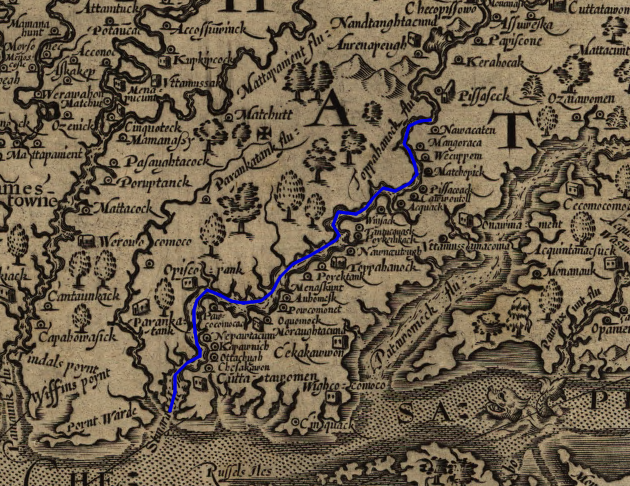
Powhatan's control over Tsenacomoco may have been greater on the southern bank of the Rappahannock River, which is one explanation for the concentration of Algonquian settlements north of that river (marked by blue line - and on John Smith's map, "north" is to the right, not at the top)
Source: Library of Congress, Virginia / discovered and discribed by Captayn John Smith, 1606
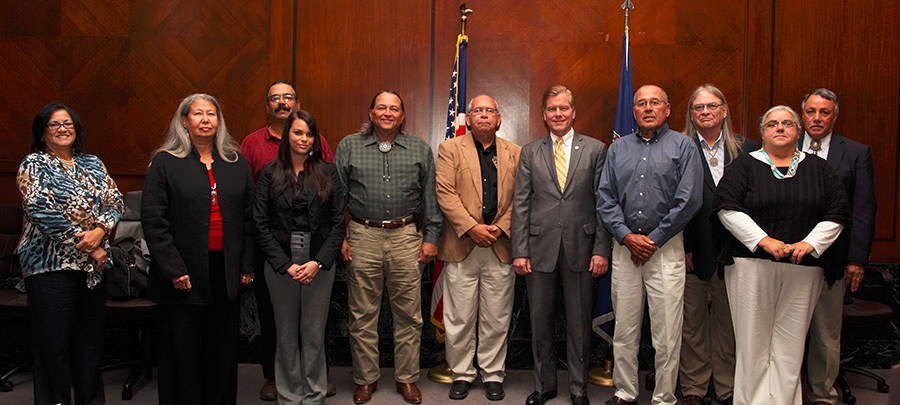
chiefs of Virginia's state-recognized tribes with Gov. McDonnell (November 2012)
from L to R: Rappahannock Chief Anne Richardson, Nottoway Chief Lynette Lewis Allston, Upper Mattaponi Assistant Chief Frank Adams, Pamunkey Tribal Member Ashley Atkins, Cheroenhaka (Nottoway) Chief Walt Brown, Upper Mattaponi Chief Kenneth Adams, Governor McDonnell, Mattaponi Chief Carl Custalow, Patawomeck Chief Robert Green, Monacan Chief Sharon Bryant, Chickahominy Assistant Chief Wayne Adkins
Source: Commonwealth of Virginia
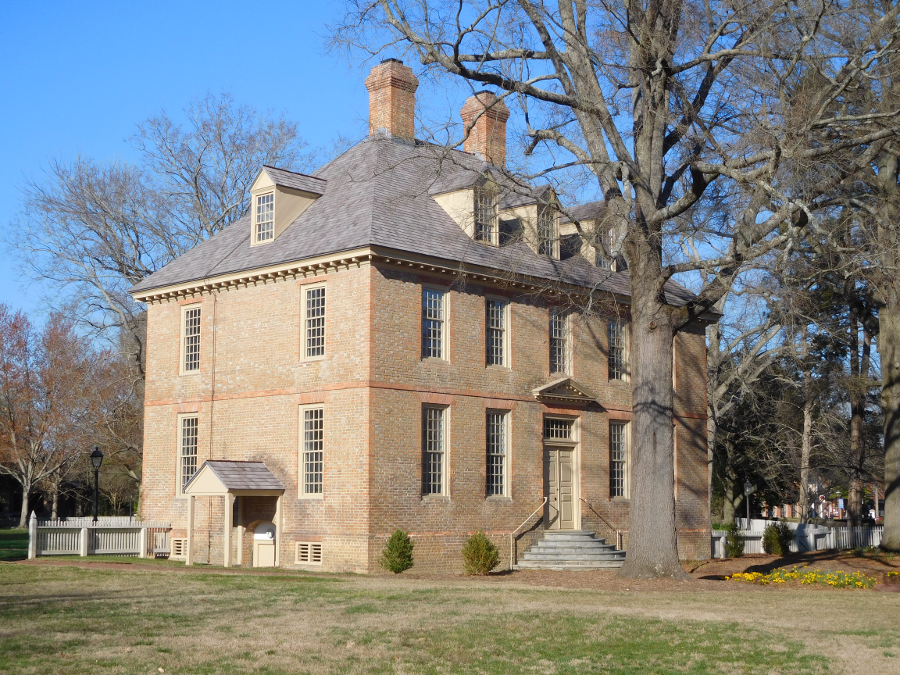
William and Mary built the Brafferton building in 1723 to educate Native Americans
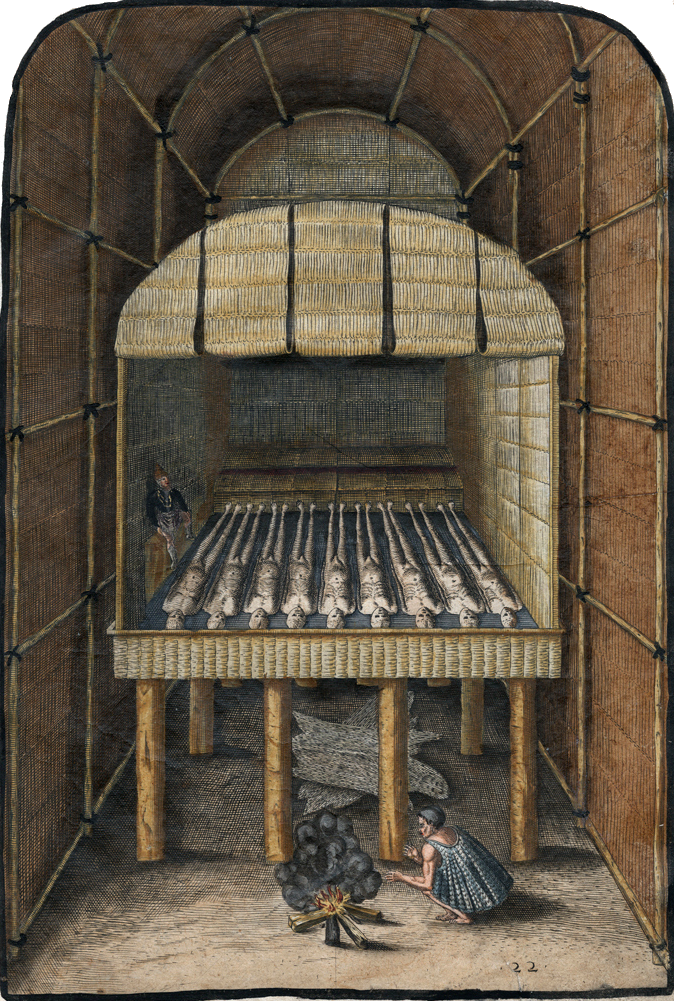
in Powhatan's paramount chiefdom, after werowances died and their flesh decayed the bones were wrapped and retained in temples
Source: LearnNC, Theodor de Brys engraving Indian Charnel House (from Thomas Hariot's 1588 book A Briefe and True Report of the New Found Land of Virginia)
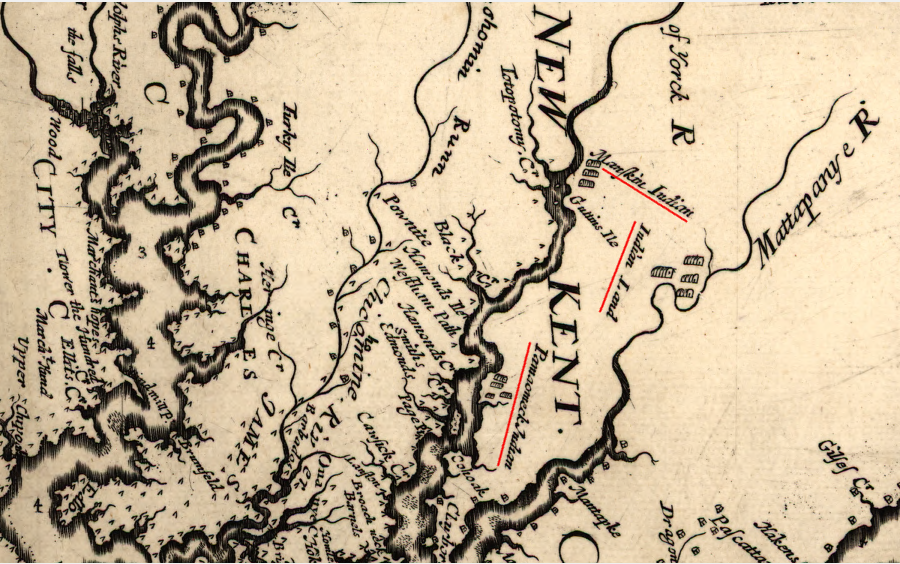
when Augustine Herrman produced his map sixty years after the English landed at Jamestown, Native Americans had been forced off the Peninsula to towns north of the York and Pamunkey rivers (NOTE: map is oriented with North to the right)
Source: Library of Congress, Virginia and Maryland as it is planted and inhabited this present year 1670
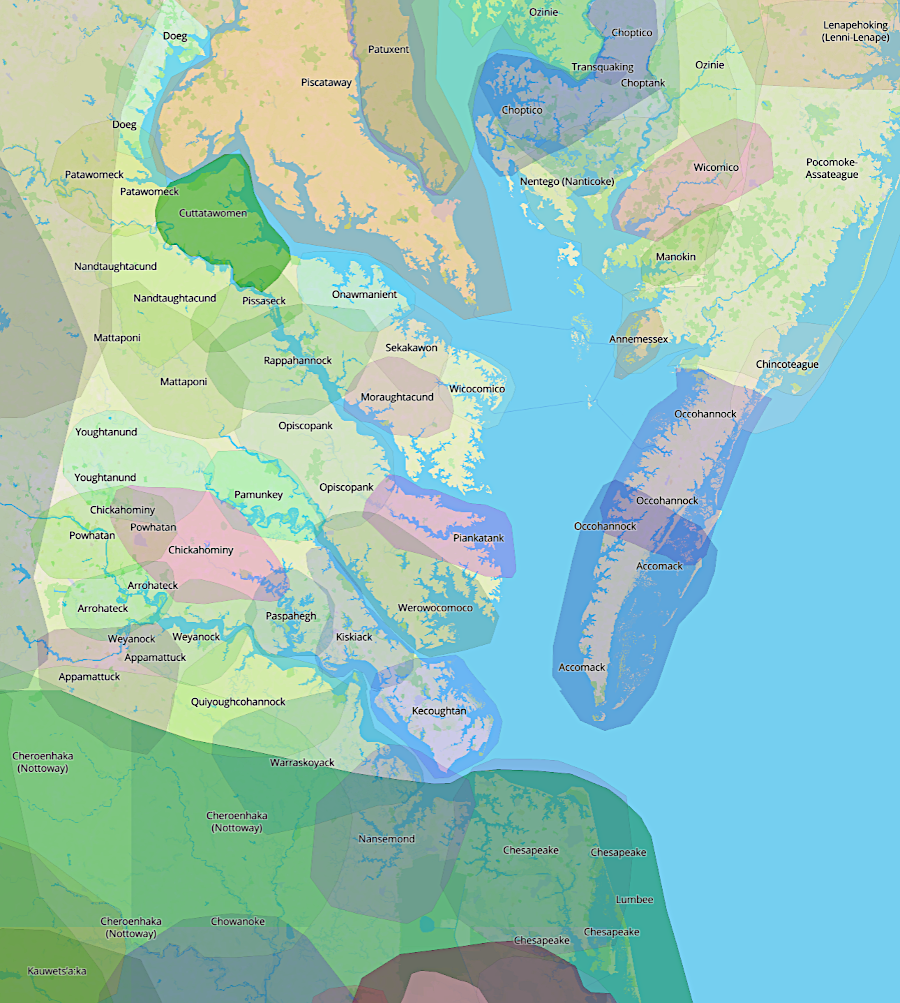
the English documented where Native American groups lived at the start of colonization
Source: Native Land Digital
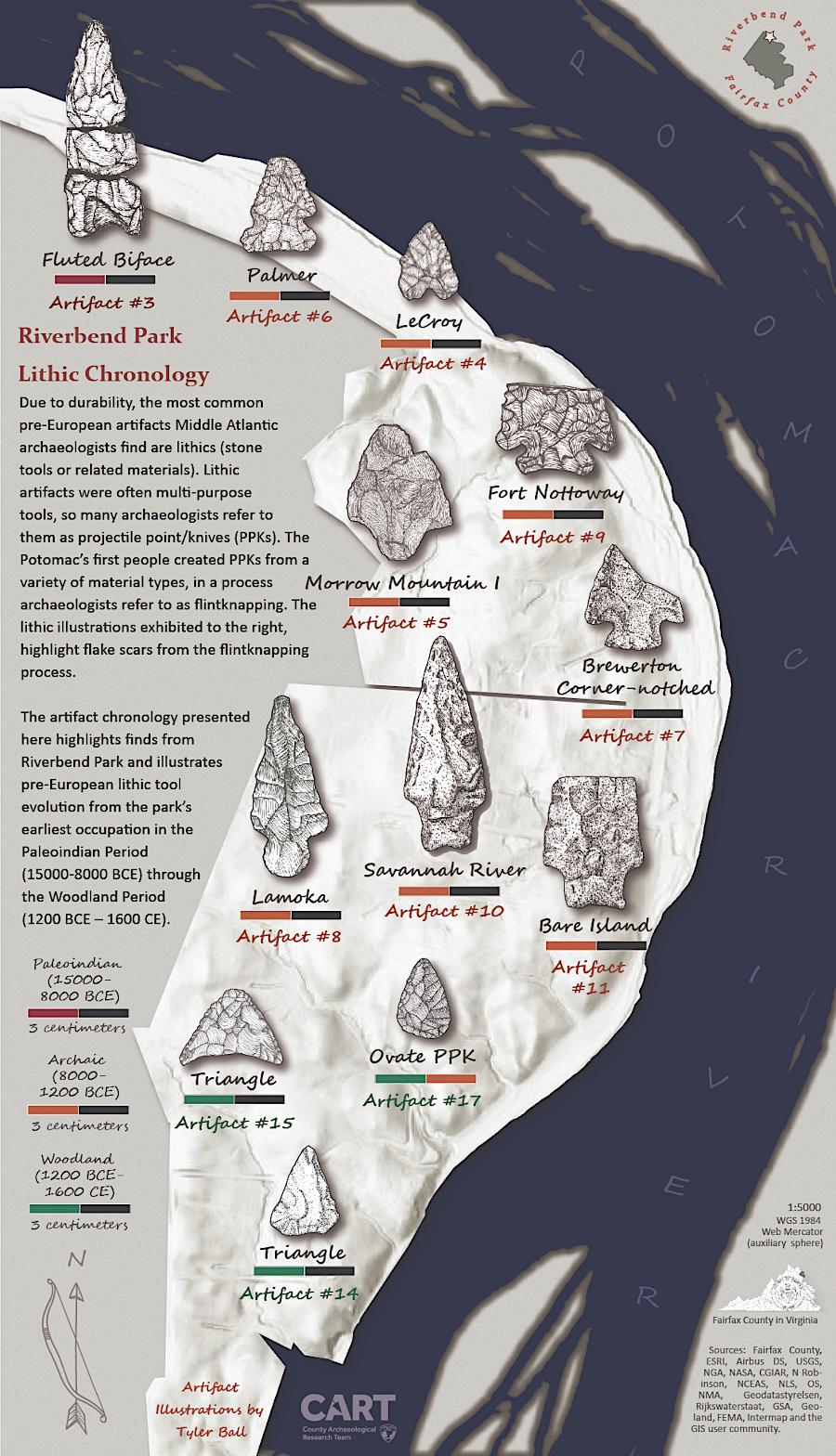
archaeology of Riverbend Park was highlighted on GIS Day 2023 in Fairfax County
Source: Fairfax County Archaeological Research Team (CART), People of the Potomac